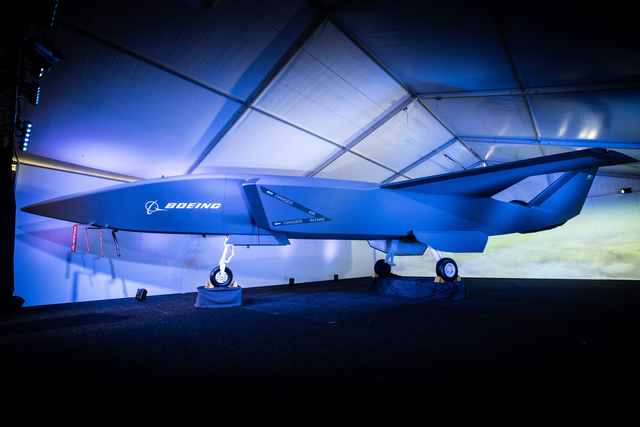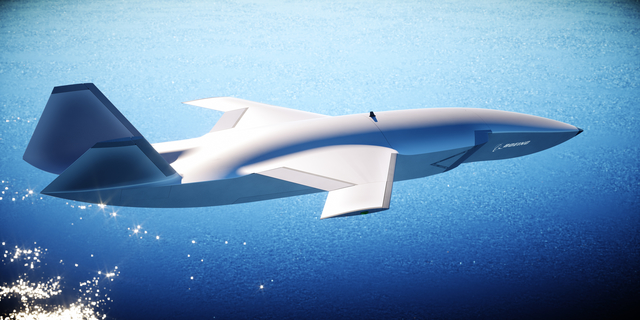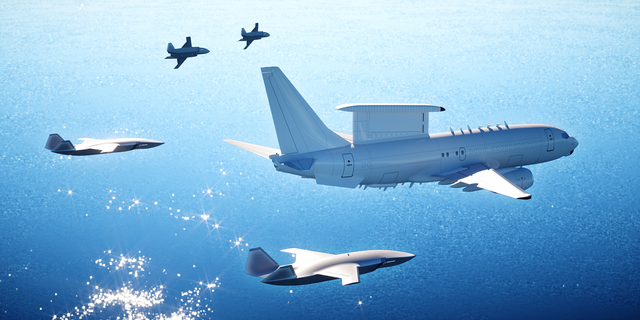Boeing Australia unveiled at the Avalon air show in Victoria, Australia a mock-up of a new unmanned air vehicle called the Airpower Teaming System, designed to fly as a loyal wingman alongside fourth- and fifth-generation fighter aircraft.
Similar to the US Air Force Laboratory Loyal Wingman concept, Boeing says it is co-developing the drone with the Government of Australia, but has designed the drone not to any specific military requirement. Boeing and Australia will produce a concept demonstrator called the Loyal Wingman - Advanced Development Programme that is intended to provide key learnings toward production of the Boeing Airpower Teaming System.
The forthcoming production model of the aircraft will resemble initial prototypes, though the guts of the UAV will be highly modifiable, says Boeing. That would allow different military operators to swap payloads such as intelligence, surveillance and reconnaissance sensors, says the company.
Boeing anticipates the UAV will make its first flight in 2020. The company has committed to building three prototypes at an undisclosed location in Australia, but declines to disclose where production examples of the aircraft would be manufactured. The Airpower Teaming System is the first unmanned aircraft designed and built by Boeing outside the USA, the company says.

Boeing Airpower Teaming System mock-up
Boeing
With the Airpower Teaming System, Boeing joins Kratos Defense & Security Solutions in a rapidly-forming market for drones capable of teaming with fast-moving manned aircraft such as fighters like the Boeing F/A-18 Super Hornet or Lockheed Martin F-35 Lightning II. The vision: dozens of cheap and expendable UAVs flying and fighting alongside expensive manned aircraft – a new air force structure intended to greatly expand the lethality of the USA and allies.
Prior to news of the Boeing-Australia deal, the USA had been the only country to explicitly fund and outline an interest in so-called loyal wingman platforms. However, Boeing says that growing threats from Great Power nations – China and Russia – is making this sort of technology more appetising to militaries worldwide.
Russia and China have invested billions of dollars in upgrading their surface-to-air missile defence networks, making it more difficult for the USA and allies to penetrate their airspace in the event of war, even with stealthy fifth-generation fighters such as the F-35. What’s more, by investing in anti-ship cruise missiles with longer ranges, Russia and China have the potential to push back US aircraft carriers far from their shores, a distance which stretches the strike range of manned aircraft.
So-called loyal wingman drones could be sent where air forces would rather not fly expensive aircraft and human pilots.

Rendering of Boeing Airpower Teaming System with F/A-18 Super Hornets
Boeing
Boeing declined to say how much each Airpower Teaming System would cost, but Kratos Defense has claimed that it will be able to produce its UAVs for as little as $2 million each.
“It is a real disruptive price point,” says Kristin Robertson, vice president and general manager of Boeing Autonomous Systems, without giving a specific cost. The aircraft will have “fighter-like capability at a fraction of the cost,” she says.

Rendering Boeing Airpower Teaming System flying solo
Boeing
The Airpower Teaming System drone will measure 11.7m (38ft) long and have range of more than 2,000nm (3,704km), says Boeing. Boeing declines to say if the aircraft’s shape or skin would give it a stealthy radar cross section. The company also declined to say its top speed, but says the UAV would keep pace with modern fighter aircraft.
“As you are screaming along at 600kt in your Super Hornet, then you have these systems flying around you,” says Shane Arnott, director of Boeing Phantom Works international, the Boeing unit helping develop the new UAV. “You’ll have four to six systems that are a logical extension of your fighting capability; they are under your command.”
The UAVs will use artificial intelligence software to fly independently or in support of manned aircraft while maintaining safe distance between other aircraft, says Boeing.

Rendering of Boeing Airpower Teaming System with airborne early warning and control aircraft
Boeing
In addition to supporting intelligence, surveillance and reconnaissance missions, the UAV would be capable of conducting electronic warfare.
“It’s a configurable system,” says Arnott. “The nose has a very significant payload area that is built to enable that sort of multi-mission nature.”
Arnott declines to say if the aircraft would be capable of carrying weapons internally or externally.
Unlike some of Kratos Defenses’ UAVs, which are based on target drones with rocket-assisted take-off abilities, Boeing’s Airpower Teaming System will land and take off conventionally with landing gear. The aircraft isn’t designed to land on carriers, but Robertson says there is nothing in its design stopping the company from adding that capability.
Source: FlightGlobal.com


























